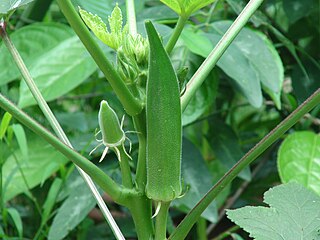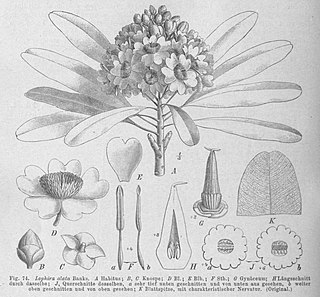
Sesame is a plant in the genus Sesamum, also called benne or gingelly. Numerous wild relatives occur in Africa and a smaller number in India. It is widely naturalized in tropical regions around the world and is cultivated for its edible seeds, which grow in pods. World production in 2018 was 6 million metric tons, with Sudan, Myanmar, and India as the largest producers.

Okra, Abelmoschus esculentus, known in some English-speaking countries as lady's fingers, is a flowering plant in the mallow family native to East Africa. It has edible green seed pods. Cultivated in tropical, subtropical, and warm temperate regions around the world, okra is used in the cuisines of many countries.

Sesamum is a genus of about 20 species in the flowering plant family Pedaliaceae. The plants are annual or perennial herbs with edible seeds. The best-known member of the genus is sesame, Sesamum indicum, the source of sesame seeds. The species are primarily African, with some species occurring in India, Sri Lanka, and China. The origin of S. indicum is uncertain, as it is widely cultivated and naturalized in tropical regions. The genus is closely related to the strictly African genus Ceratotheca and is itself probably African in origin.

Pedaliaceae, the pedalium family or sesame family, is a flowering plant family classified in the order Lamiales. The family includes sesame, the source of sesame seeds.

Amaranthus blitum, commonly called purple amaranth or Guernsey pigweed, is an annual plant species in the economically important plant family Amaranthaceae.

Amaranthus viridis is a cosmopolitan species in the botanical family Amaranthaceae and is commonly known as slender amaranth or green amaranth.

Corchorus capsularis, commonly known as white jute, is a shrub species in the family Malvaceae. It is one of the sources of jute fibre, considered to be of finer quality than fibre from Corchorus olitorius, the main source of jute. The leaves are used as a foodstuff and the leaves, unripe fruit and the roots are used in traditional medicine.

Celosia trigyna is a plant species commonly known as woolflower for its curious flowers.

Momordica balsamina is a tendril-bearing annual vine native to the tropical regions of Africa, introduced and invasive in Asia, Australia, Central America, and North America, where they have been found in some parts of Florida. In 1810, Thomas Jefferson planted this vine in his flower borders at Monticello along with larkspur, poppies, and nutmeg.
Abelmoschus caillei, the West African okra, is a plant species in the family Malvaceae. It occurs in humid areas of West and Central Africa, where it is used as a vegetable. It originated as an allopolyploid hybrid of Abelmoschus esculentus and A. manihot, and is often mistaken for either of those two plants. It was officially described elevated to the status of a species in 1988. The same hybrid was produced experimentally in Japan where it is known as Abelmoschus glutino-textile.
Acalypha bipartita is a species in the botanical family Euphorbiaceae. It occurs widely in Africa where it is eaten as a vegetable, or fed to animals. The leaves are considered nutritious, as they contain a high concentration of calcium. It is often found as undergrowth in the forest, on the edges of the forest, and in wooded grasslands, particularly in Sudan, Uganda, Kenya, eastern Zaire, Burundi, Rwanda, and Tanzania. The stems are often used in making baskets.

Alternanthera sessilis is a flowering plant known by several common names, including sissoo spinach, Brazilian spinach, sessile joyweed, dwarf copperleaf. It is cultivated as a vegetable worldwide.

Barleria obtusa, the bush violet, is a species of flowering plant in the family Acanthaceae. It occurs naturally along forest margins in the summer rainfall region of South Africa and in Mozambique. It is widely cultivated as a decorative garden shrub.

Acanthosicyos naudinianus, known as the Gemsbok cucumber, is a perennial African melon with edible fruits and seeds.
Allanblackia floribunda, known in English as 'tallow tree', is a species of flowering plant in the family Clusiaceae that has been long used in traditional African medicine to treat hypertension. It is a common understory tree in rainforests in western central Africa - from Sierra Leone to western Cameroon, and on into the Democratic Republic of Congo and Uganda. The medium-sized tree is evergreen and dioecious. The wood is said to be resistant to termites but is not particularly durable. It is fairly easy to work and finishes well but it is of little commercial importance though it has appeared on the market in Liberia as "lacewood".

Sesamum radiatum is a species of flowering plant in the Pedaliaceae. It is in the same genus as sesame, and is known by the English common names benniseed, black benniseed, black sesame, and vegetable sesame. It is native to west and central Africa, has been cultivated since ancient times in Africa, and is sometimes also used in tropical Asia where it has become naturalized to a small extent.

Ceratotheca is a genus of plants in the family Pedaliaceae comprising about five species native to worldwide tropical areas and to southern Africa.

Sesamum alatum is a species of flowering plant in the Pedaliaceae. It is in the same genus as sesame. In English it is called winged-seed sesame. Its native range spans from Western Sahara to Egypt and south to KwaZulu-Natal in South Africa.

Myrianthus arboreus, the giant yellow mulberry or monkey fruit, is a dioecious tropical tree in the genus Myrianthus. It lives in the tropical Central African countries of Central African Republic, Gabon, Cameroon, Nigeria, and Tanzania. Its chromosome count is 2n = 28.

Lophira lanceolata, commonly known as the dwarf red ironwood, is a species of tree in the family Ochnaceae which is native to tropical West and Central Africa. The timber is used for heavy construction, an edible oil can be extracted from the seeds and various parts of the plant are used in traditional medicine.

















